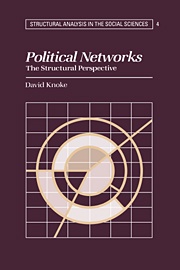Book contents
- Frontmatter
- Contents
- List of tables and figures
- Preface
- Acknowledgments
- 1 Politics in structural perspective
- 2 Voting and political participation
- 3 Social movements (written with Nancy Wisely)
- 4 Organizational power (written with Naomi J. Kaufman)
- 5 Community power structures
- 6 Elites in the nation state
- 7 International relations (written with Jodi Burmeister-May)
- 8 Toward a structural political economy
- Appendix: Some fundamentals of network analysis
- References
- Index
Appendix: Some fundamentals of network analysis
Published online by Cambridge University Press: 02 October 2009
- Frontmatter
- Contents
- List of tables and figures
- Preface
- Acknowledgments
- 1 Politics in structural perspective
- 2 Voting and political participation
- 3 Social movements (written with Nancy Wisely)
- 4 Organizational power (written with Naomi J. Kaufman)
- 5 Community power structures
- 6 Elites in the nation state
- 7 International relations (written with Jodi Burmeister-May)
- 8 Toward a structural political economy
- Appendix: Some fundamentals of network analysis
- References
- Index
Summary
The most important steps in any social network analysis are to delineate a concrete population of social objects and one or more types of relationships connecting them (Fararo and Skvoretz, 1986). The population may be all Fortune 500 corporations and the relations may be their interlocking directors and their product purchases from one another. Or the population is all capitalist industrial nations, with their trade ties and military alliances as the two relations of primary interest. Or the people in a social movement may comprise the population, with their coordinated participation in protests and demonstrations as the focal relation.
Analytic boundary specification of any social system is a crucial but poorly understood process (Laumann, Marsden and Prensky, 1983; Pappi, 1984). The realist assumption is that all member entities are consciously aware of who belongs and who does not. Inclusion may be based on a face-to-face primary relationship, such as friendship circle, or on a formal entrance qualification, as in joining a ward political organization. Alternatively, the nominalist assumption is that network closure can be imposed by the analyst's own requirements, with this specification conforming to reality. For example, a Marxist nominalist may define as working class all employees who do not own the means of production. Frequently, researchers combine subjective and objective criteria to stipulate network boundaries.
- Type
- Chapter
- Information
- Political NetworksThe Structural Perspective, pp. 235 - 240Publisher: Cambridge University PressPrint publication year: 1990

